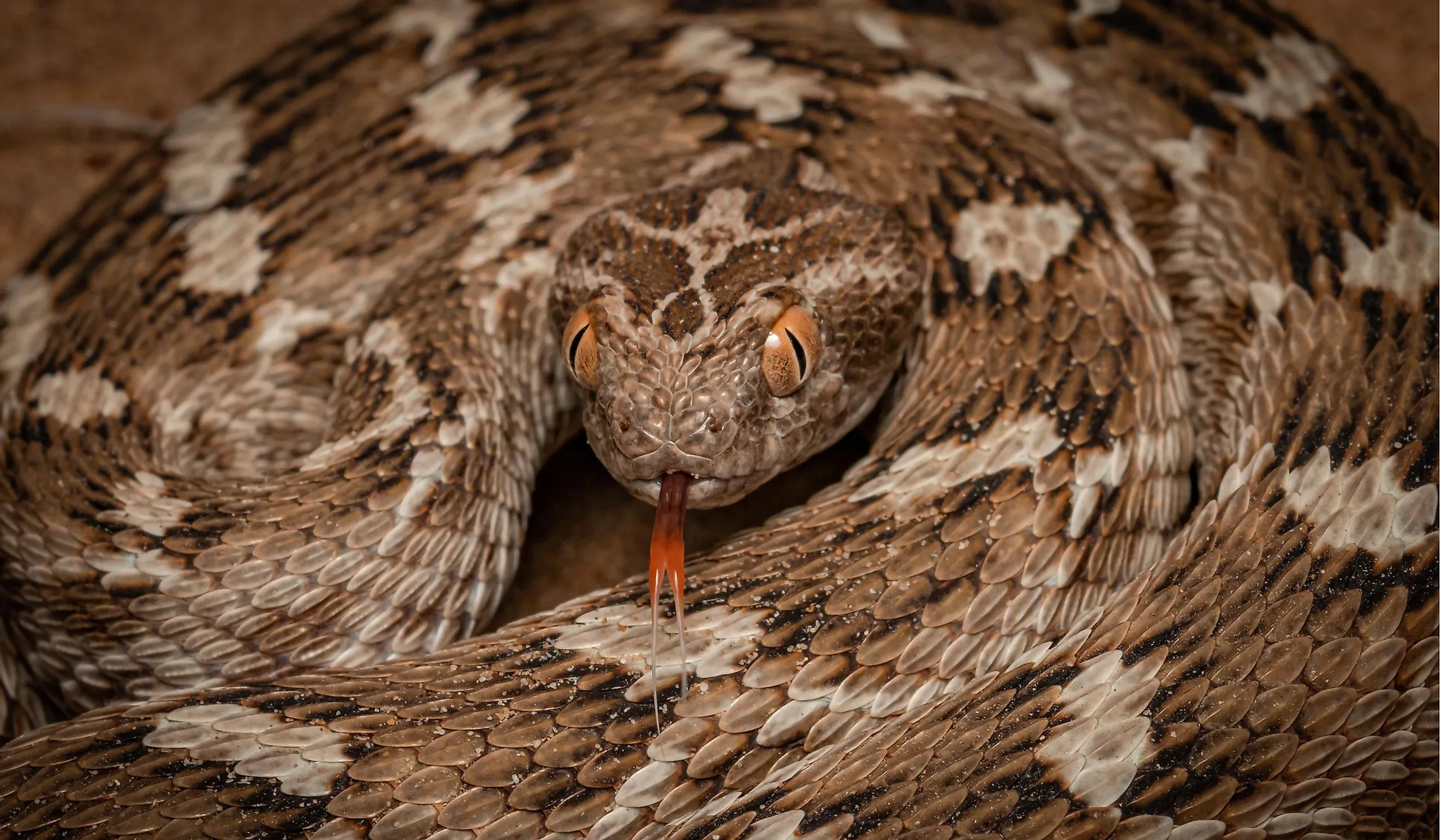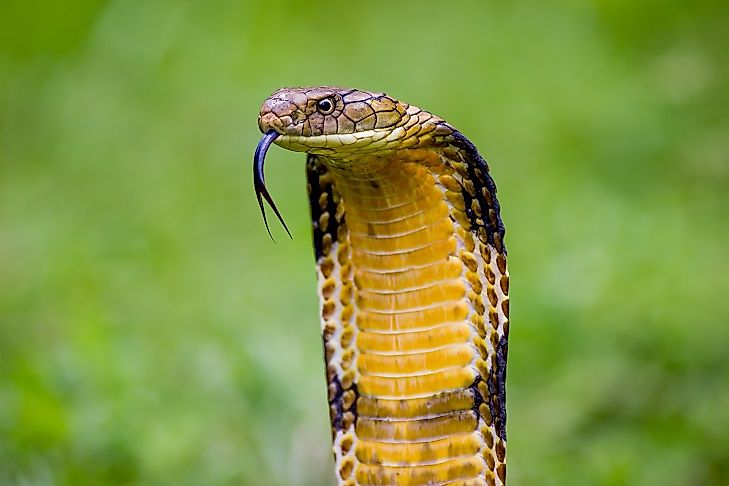
Which Snake Has Killed the Most Humans?
Throughout history, snakes have been depicted in various myths and legends, symbolizing both destruction and healing. For instance, Apophis in Egyptian mythology and Jormungandr in Norse mythology represented chaos and destruction. In contrast, snakes like the Mesoamerican feathered serpent deity Quetzalcoatl or Kukulkan, and the Hindu nagas, who protected Siddartha Gautama, the Buddha, are revered as divine entities.
In reality, there are about 3,900 species of snakes distributed globally, extending as far north as the Arctic Circle in Scandinavia and as far south as the arid deserts of Australia. Snakes are present on every continent except Antarctica. Of these species, approximately 600 are venomous, and only a fraction of these are capable of causing fatal injuries to humans.
The most deadly snake in terms of human fatalities is the saw-scaled viper (Echis carinatus), found in the Middle East, Central Asia, India, Sri Lanka, and Africa. This species has caused more human deaths than any other snake, surpassing even the Inland Taipan, Black Mamba, and King Cobra.
The Saw-Scaled Viper: A Deadly Predator

Species of saw-scaled vipers or carpet vipers inhabit arid regions and dry savannahs north of the Equator across Africa, Arabia, southwestern Asia, India, and Sri Lanka. With a stout body terminating to a pear-shaped head, vertically elliptical pupils, rough and strongly keeled scales, and a short, thin tail, they grow in lengths from 1 to 3 feet—small for creatures that carry a heavy cocktail of venom. On both sides of the viper’s body are several rows of obliquely arranged serrated scales, which give it the name “saw-scaled,” with pigments of differing shades of brown, gray, or orange with darker dorsal blotches and lateral spots that let it blend perfectly to the desert.
Echis carinatus are sidewinders, meaning they move by sidewinding locomotion. As nocturnal creatures, they emerge from sheltered burrows or crevices after twilight and hunt for mammals, birds, lizards, amphibians, and invertebrates such as scorpions and centipedes; they also eat other snakes. Egg-laying species, producing up to 23 eggs per female, reside in northern Africa, whereas live-bearing species inhabit the Middle East and southern Asia.
Their small figure belies an irritably aggressive nature, which is one reason why these snakes are so dangerous to humans. When alarmed—and they are easily alarmed—the saw-scaled vipers will move slowly with the body looped into S-shaped folds. The oblique scales are so shaped that when sidewinding in terrifying motions, they rake against one another, creating a prolonged rattling hiss or sizzle that acts as an ominous warning to predators or unwanted trespassers. These snakes strike quickly. Their venom produces a bevy of lethal symptoms ranging from random bleeding, heart palpitations, and brain hemorrhage to blood-clotting trouble and internal bleeding, which can lead to acute kidney failure. The saw-scaled viper has a maximum yield of 70 mg of venom in a single bite, and the average person only needs 5 mg to be fatally wounded.
But the saw-scaled viper’s venom doesn’t just kill—it destroys tissues around the bitemark so that even if victims survive, they can still lose fingers, toes, or entire limbs. It is estimated that around 125,000 people die from snakebites every year; around 400,000 more face amputations if antivenom administrations are offered too late; and within these data, the saw-scaled viper has caused an estimated 5,000 human fatalities annually.
As a hardy and adaptive creature, the saw-scaled viper has a propensity to dwell near human settlements. Their small size and the coloration of their environment camouflage them too well for humans to easily spot and avoid. It becomes inevitable that a human and a saw-scaled viper might encounter each other. Most of these encounters, due to the snake’s aggressive and fearless nature, end terribly for humans. Moreover, because most attacks originate from locations in Africa, the Middle East, and southern Asia that lack much medical facilities or proper healthcare education, few victims of saw-scaled vipers are treated with antivenom in time.
Comparing Other Deadly Snakes

Aside from a deadly kill streak, is there anything special about the saw-scaled viper in contrast to other venomous ophidians?
Certainly, the saw-scaled viper does not live in the humid jungle environments of South and Central America, unlike the terciopelo or fer-de-lance (Bothrops asper), a snake that reaches lengths of 8 feet and weighing an average of 10-13 pounds. The terciopelo has an average of 500-1500 mg of venom in a single bite, and since it takes 3mg to kill a mouse, an average of six humans can die from one bite from the snake.
Obviously, the saw-colored viper is not as massive as the king cobra (Ophiophagus hannah), which holds the rank of the world’s largest venomous snake, with confirmed lengths of 18 feet (although most do not exceed 12 feet). The king cobra is found predominantly in the forests of India, the Philippines, and Indonesia; its venom is voluminous and potent enough to kill an elephant in a few hours (400-1000 mg per bite).
Furthermore, the saw-scaled viper’s bite is notably more blatant and disastrous than the bite of a boomslang (Dispholidus typus), a typically 6-foot long, tree-traveling snake found in the dense African thickets of Swaziland, Botswana, Namibia, Mozambique, and Zimbabwe. Nor is the saw-scaled viper’s venom the most lethal venom in the world—indeed, that position is taken by the inland taipan (Oxyuranus microlepidotus), living well in Australia with an LD50 (lethal dose) rating of 0.01mg and 44-110mg of venom per bite; it is capable of killing 289 humans in a single bite.
So what truly sets the saw-scaled viper apart from its venomous cousins is its knack for camouflage, irritable aggressiveness towards humans, and unfortunate proximity to dense human populations in Africa, the Middle East, India, Sri Lanka, and Pakistan. It is a collection of unlucky factors that give the viper its morbid kill ratio compared to other snakes. If the inland taipan were the one living in densely-populated areas in many countries, it would have beaten the saw-scaled viper’s kill score. As it currently stands, the saw-scaled viper ranks as number one due to an unfortunate series of geological and evolutionary happenstance.
Medical and Cultural Impact
Being bitten by a saw-scaled viper may not be the end. Like any snakebite, it can be treated. But there needs to be enough time and access to proper healthcare services, hospitals, and treatments to counteract the venom of a saw-scaped viper. A vital tip for when one is bitten is to prevent movement of the affected arm or leg, tying constricting bandages above the fang mark and generally not letting the venom circulate. Since the viper’s venom destroys tissue and ruptures blood vessels, it is important not to let the toxins spread havoc in other sectors of the body. In worst-case scenarios, one may have to amputate the bitten portion to ensure the entire body’s survival.
Ultimately, antivenin therapy and intravenous hydration administered by nearby health centers are the surefire methods to saving victims of saw-scaled viper bites without amputation. Unfortunately, because many saw-scaled viper attacks emanate in marginalized sectors of Africa, the Middle East, India, Sri Lanka, and Pakistan, resources are scarce, and healthcare is far from charitable to treat everyone afflicted by snakebites. India alone has around 58,000 individuals dying from snakebites every year, the highest rate in the world. Not enough funds are prioritized to produce quality antidotes or antivenin since snakes are not considered medically important. Even if antivenins are manufactured, the distribution can be problematic, as stocks may be inadequate, especially in rural hospitals and small healthcare centers. Treatments are further exacerbated by the viper’s venom itself: the venom changes over different seasons, different geographies, and different saw-scaled viper species. How well an antivenin works depends on the potency and volume of the venom. Other times, people bitten by the viper may not seek treatment at the hospital until hours after the bite, relying first on natural or folk remedies, as observed in India alone.
There is a remedy for every poison, fortunately. The Irula Snake Catcher’s Industrial Co-operative Society in India, the country’s largest producer of quality snake venom, has manufactured antivenin for snakebites of all kinds. The Irular, one of India’s oldest indigenous communities and known for their extraordinary ability to trace and catch snakes since their hunter-gatherer era, have curbed snakebites by capturing 13,000 snakes—be it Echis carinatus or other venomous snakes—per year and storing them in captivity for 21 days under India’s Wildlife Act. Venom-milking captured snakes have exponentially contributed to the study of snake venom and the systemization of antivenins. Other developments include research on preventing snake venom from activating by using metal chelators and peptidomimetic hydroxamate inhibitors, which, respectively, reduce the available pool of metal ions (Zn2+) required for snake venom metalloproteinases (SVMP)—catalyzing agents that activate the venom’s potent potential—and directly bind the metal ions present in the catalytic core of the metalloproteinase.
Still, more is needed to be done to effectively curb the issues posed by the saw-scaled vipers. It is not enough to simply avoid living in places where the saw-scaled vipers reside, nor is it so simple to eradicate the vipers to the point of endangerment or extinction. Recommendations range from manufacturing region-specific antivenin dedicated to a particular area where there is a strong demand for snake-related healthcare, synthesizing a more diverse antivenin—a super cocktail—that can effectively neutralize a spectrum of snakebites, and supporting and financing local healthcare services in distribution, storage, and production of antivenins. What matters now is awareness, prevention, and further research on the viper-human relationships in afflicted areas.
The Ouroboros may be the most fitting symbol of a snake’s dichotomous contributions to human beings: as a motif for destruction, snakes take the top spot for ruining lives. But as a metaphor for rebirth, snakes also contribute to advancements in medicine, cures, and antitoxins that combat snake venom. Although the saw-scaled viper is responsible for more human deaths than any other snake, it is vital to continue studying its venom for medical applications and the synthetization of antivenins to treat bites. Of course, it is much better to prevent viper-human engagements entirely, so there ought to be educational mechanisms in place to keep people mindful of saw-scaled vipers; and if prevention is not enough, there should be nearby healthcare services to render treatments in remedying snakebites as soon as possible.
It would be wrong to consider the saw-scaled viper as a malicious serpent like the one from Eden’s Garden and believe that the viper’s eradication is a permanent solution. Any other venomous snake as lethal or more so than the saw-scaled viper could have easily taken the number one spot if they happened to dwell in many countries inhabited by a dense population of ill-prepared and ill-medicated humans. If it attacks, it attacks out of instinct for self-defense. We should, at least, be mindful of exploring regions teeming with saw-scaled vipers and not get trapped in a self-eating cycle of ignorance and revulsion.











